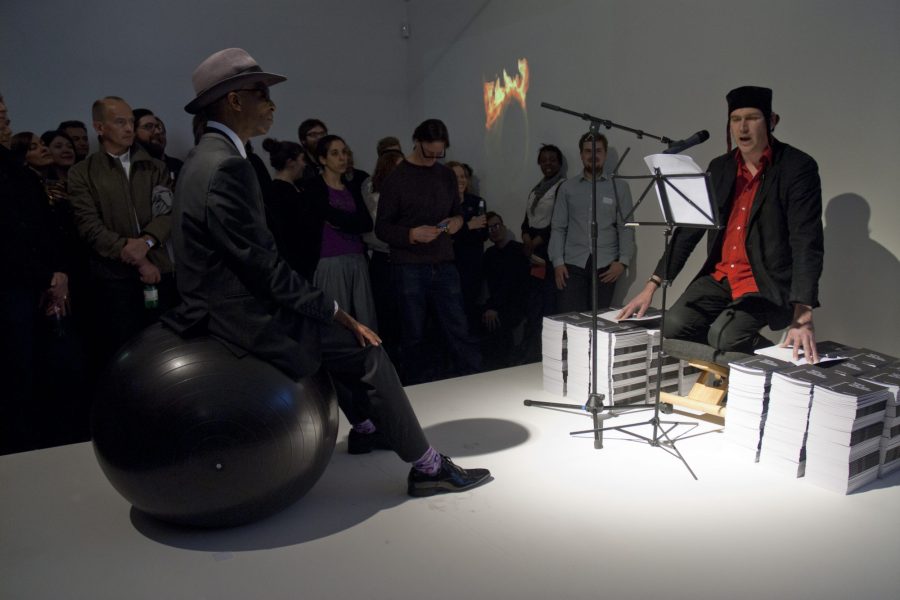
Elements of humour but also the uncanny or unnerving seem to pervade your works; how fine do you feel the line between the two is, in the context of your practice?
At times I think they can be really close, almost one and the same, at other times they can be far away. For me they both kind of do the same thing in different ways. When you have a sense of something emotional or logical but you’re not quite able to understand it, that can be really scary or really funny. I guess it’s about the ways in which the logic or emotion breaks down that defines how scary or funny the experience is.
In a sense, there is a slippage between sculpture and performance in Zip and Zing; the partial shielding of the body and the lack of subjectivity attached to these legs almost transforms them into something more akin to autonomous moving objects. How have you played with ideas of ‘slippages’ in the work and how do you feel the categories of sculpture or performance may influence separate readings of the work?
There’s space for them to slip and be in a place where you’re thinking about things being one and the same. I’m not sure how much I like this, in terms of a place one might end up thinking about. Like thinking nothing is everything and everything is nothing, it becomes completely reductive; it’s like pulling a lid over something. But it’s also down to the individual and their ideas and feelings about what performance and sculpture are, and what they can be.
Could you expand a little on how Zip and Zing is influenced by the practice of Robert Gober and Erwin Wurm? What is it that interests you about these artists’ works specifically?
What I like about Gober’s work is more the uncanny and unnerving stillness and weirdness that they occupy. But the way they do this in a weird sexual way. They remind me a lot of certain feelings one might have after waking up from having a strange sexual dream and then trying to apply the dream to waking-life logic. Wurm’s work doesn’t haunt me as much, but I like the quickness of the humour in his one minute pieces and some of his photo pieces.
Different notions of time exist within Zip and Zing: occupying time, suspending time, marking time, waiting time. How were you thinking about different time constructs when creating the work?
To be honest I was not thinking that much about the different types of time until the piece was made. Then once the work was done I really felt that the work, in all the ways it was existing, was giving time all these different characteristics. In a silly way, in terms of relating, time became quite like a creature or a being.
Do you agree that an essence of theatre permeates the work, as the stage is set and the curtain lifts to reveal the protruding legs? How important is the ‘unseen’ to this work – the space behind the scenes?
There is definitely a theatrical element. And the unseen has to be there, because if it wasn’t the work wouldn’t be there.
How many people participated in the work through the duration of the exhibition? Have any of these participants communicated to you their experience ‘within’ the work, and if so, how does this further influence your own perception of the piece?
I think it’s been near to 60 people. I’ve heard back from people who were performing at the opening; some groping went down, but it think it was affectionate! I think with all works that involve humans performing, there is the viewer’s experience and the performer’s experience. And they are very different. I’ve always felt that there’s a lot of performance where I wish I was the performer, as it seems like what they experience is better than the viewer, some of Abramović’s work does that for me, her sitting and staring one at MoMA for example, but then there’s also works of hers and lots of other folk where I think ‘I’m glad I’m not doing that!’
What have you got planned for this coming year? Do you have further exhibitions and works that we can look out for?
The next solo thing I have line up is at Tanya Bonakdar Gallery (New York) later in the year.
A strong curatorial concern of SHOW is to examine the intrinsic ephemerality of any live moment, and thus to consider further the role that documentation, relics and records might play in capturing the passing of time. What are your views about trying to prolong, contain, or capture the essence of your performance art?
It depends on the work. With some works it feels right that you have to document, and others not. With this work for this show a film was made by somebody else. Having seen the film I feel that the work shouldn’t exist documented as a film—an image and written descriptions yes, a film no. Mainly for me, I think the film is too much something else. I feel documenting is also quite an open process. A live moment can be documented in many ways, and being live you only have present time and often you can’t know in the present time how something will look or be experienced in documented time. Documenting is then something you do and then it becomes a material you can then use to expand on the recorded existence of a live time experience.
